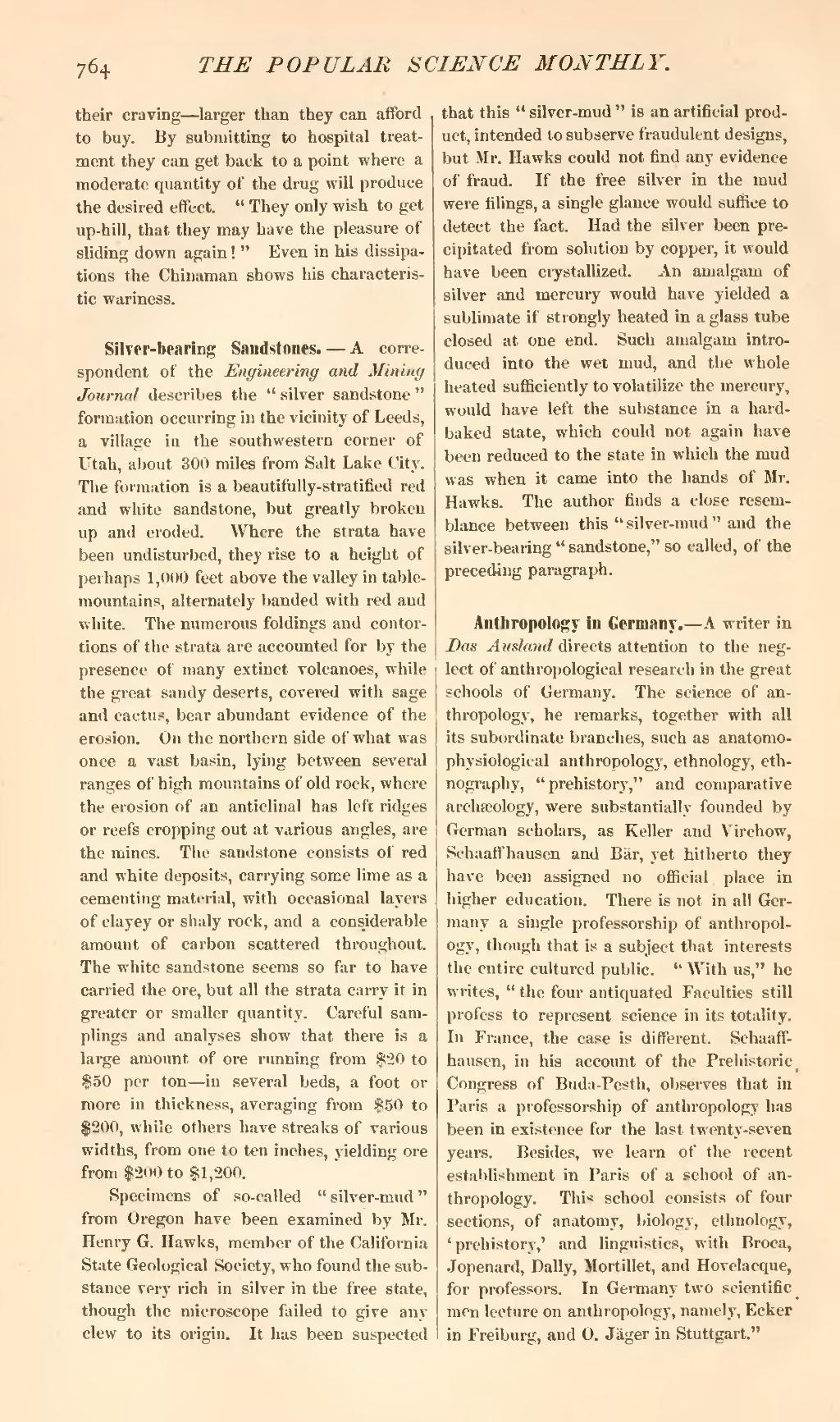their craving—larger than they can afford to buy. By submitting to hospital treatment they can get back to a point where a moderate quantity of the drug will produce the desired effect. "They only wish to get up-hill, that they may have the pleasure of sliding down again!" Even in his dissipations the Chinaman shows his characteristic wariness.
Silver-bearing Sandstones.—A correspondent of the Engineering and Mining Journal describes the "silver sandstone" formation occurring in the vicinity of Leeds, a village in the southwestern corner of Utah, about 300 miles from Salt Lake City. The formation is a beautifully-stratified red and white sandstone, but greatly broken up and eroded. Where the strata have been undisturbed, they rise to a height of perhaps 1,000 feet above the valley in table mountains, alternately banded with red and white. The numerous foldings and contortions of the strata are accounted for by the presence of many extinct volcanoes, while the great sandy deserts, covered with sage and cactus, bear abundant evidence of the erosion. On the northern side of what was once a vast basin, lying between several ranges of high mountains of old rock, where the erosion of an anticlinal has left ridges or reefs cropping out at various angles, are the mines. The sandstone consists of red and white deposits, carrying some lime as a cementing material, with occasional layers of clayey or shaly rock, and a considerable amount of carbon scattered throughout. The white sandstone seems so far to have carried the ore, but all the strata carry it in greater or smaller quantity. Careful samplings and analyses show that there is a large amount of ore running from $20 to $50 per ton—in several beds, a foot or more in thickness, averaging from $50 to $200, while others have streaks of various widths, from one to ten inches, yielding ore from $200 to $1,200.
Specimens of so-called "silver-mud" from Oregon have been examined by Mr. Henry G. Hawks, member of the California State Geological Society, who found the substance very rich in silver in the free state, though the microscope failed to give any clew to its origin. It has been suspected that this "silver-mud" is an artificial product, intended to subserve fraudulent designs, but Mr. Hawks could not find any evidence of fraud. If the free silver in the mud were filings, a single glance would suffice to detect the fact. Had the silver been precipitated from solution by copper, it would have been crystallized. An amalgam of silver and mercury would have yielded a sublimate if strongly heated in a glass tube closed at one end. Such amalgam introduced into the wet mud, and the whole heated sufficiently to volatilize the mercury, would have left the substance in a hard-baked state, which could not again have been reduced to the state in which the mud was when it came into the hands of Mr. Hawks. The author finds a close resemblance between this "silver-mud" and the silver-bearing "sandstone," so called, of the preceding paragraph.
Anthropology in Germany.—A writer in Das Ausland directs attention to the neglect of anthropological research in the great schools of Germany. The science of anthropology, he remarks, together with all its subordinate branches, such as anatomo-physiological anthropology, ethnology, ethnography, "prehistory," and comparative archæology, were substantially founded by German scholars, as Keller and Virchow, Schaaffhausen and Bär, yet hitherto they have been assigned no official place in higher education. There is not in all Germany a single professorship of anthropology, though that is a subject that interests the entire cultured public. "With us," he writes, "the four antiquated Faculties still profess to represent science in its totality. In France, the case is different. Schaaffhausen, in his account of the Prehistoric Congress of Buda-Pesth, observes that in Paris a professorship of anthropology has been in existence for the last twenty-seven years. Besides, we learn of the recent establishment in Paris of a school of anthropology. This school consists of four sections, of anatomy, biology, ethnology, 'prehistory,' and linguistics, with Broca, Jopenard, Dally, Mortillet, and Hovelacque, for professors. In Germany two scientific men lecture on anthropology, namely, Ecker in Freiburg, and O. Jäger in Stuttgart."
